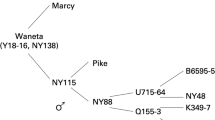Abstract
The cultivars Ori, Idit, Zohar, and Zahov have been bred specifically for adaptation to the Mediteranean climate: Ori and Idit are early tablestock cultivars, Idit is suited for “mini potatoes” (20 to 35 mm in diameter); Zohar is a midseason tablestock cultivai-, and Zahov is used as an early chipstock cultivar. The cultivars can be grown in either of the two main seasons in the Mediterranean region: the spring season (January through July) and the winter season (September through March). The cultivars have rapid emergence and early tuber set, they are tolerant to high temperatures and drought, and are not susceptible to external or internal defects. In field experiments, Idit yields were lower than the cultivar checks (Alpha, Nicola, or Desiree) in six of seven trials. However, the attractive appearance of the small oval tubers (20-35 mm in diameter) and the good aroma of the baked tubers are advantages. Yield of Ori and Zohar occasionally exceeded those of cultivar checks, and their yellowish skin, especially in sandy soils, is an advantage. Yields and tuber dry matter content of the early-maturing cultivar Zahov were similar to Hermes, a standard chipstock cultivar commonly used in Israel. The early maturation of Zahov is desirable to extend the harvest season.
Resumen
Los cultivares Ori, Idit, Zohar y Zahov han sido mejorados específicamente para adaptarse al clima del Mediterráneo: Ori e Idit son cultivares precoces para uso directo. Idit es usado como “mini papa” (20 a 35 mm de diámetro); Zohar es un cultivar de uso directo de media estación y Zahov es usado como un cultivar precoz para preparar hojuelas. Los cultivares crecen en cualquiera de las dos estaciones principales de la región mediterránea: primavera (de enero a julio) e invierno (desde setiembre hasta marzo). Los cultivares tienen rápida emergencia y tuberización temprana, son tolerantes a las altas temperaturas y sequias y no son susceptibles a defectos internos o externos. En experimentos de campo, los rendimientos de Idit fueron más bajos que los de cultivares testigos (Alpha, Nicola o Desirée) en seis de siete pruebas. Sin embargo, la apariencia atractiva de los pequeños tubérculos ovalados (20-35 mm de diámetro) y el rico aroma de los tubérculos horneados constituyen una clara ventaja. Los rendimientos de Ori y Zohar excedieron en ocasiones a los cultivares testigos y su piel amarillenta, especialmente en suelos arenosos, es igualmente una ventaja. Los rendimientos y contenido de materia seca de los tubérculos de maduración temprana del cultivar Zahov fueron similares a Hermes, un cultivar estándar para elaborar hojuelas, de uso común en Israel. La temprana maduración de Zahov es conveniente porque puede extenderse hasta la temporada de cosecha.
Similar content being viewed by others
Literature cited
Borah, M. N. and F. L. Milthorpe. 1962. Growth of the potato as influenced by temperature. Indian J Plant Physiol 5:53–72.
Dimenstein, L., N. Lisker, N. Kedar, and D. Levy. 1997. Changes in the content of steroidal glycoalkaloids in potato tubers grown in the field and in the greenhouse under different conditions of light, temperature and day length. Physiol Mol Plant Pathol 50:391–402.
Ewing, E.E., J.H. Lorenzen, M.P.Reynolds, S. Gebre-Mariam, R.G. Snyder, and M. Ben Khedher. 1987. Evaluating heat tolerance in potato.In: W.N. Chang, P.W. MacGregor, and J. Bay- Peterson (eds). Improved Vegetable Production in Asia, Food and Ferilizer Technology Center. Taipei Book Series No. 36. pp. 110–118.
Gregory, P. 1984. Glycoalkaloid composition of potatoes: diversity and biological implications. Am Potato J 61:115–122.
Hawkes, J.H. 1978. History of the potato.In: P.M. Harris (ed.). The Potato Crop: The Scientific Basis for Improvement. Chapman and Hall, London, pp. 1–14.
Levy, D. 1984. CultivatedSolanum tuberosum L. as a source for the selection of cultivars adapted to hot climates. Trop Agric (Trinidad) 61:167–170.
Levy, D. 1986a. Tuber yield and tuber quality of several potato cultivars as affected by seasonal high temperatures and by water deficit in a semiarid environment. Potato Res 29:95–107.
Levy, D. 1986b. Genotypic variation in the response of potatoes(Solanum tuberosum L.) to high ambient temperatures and water deficit. Field Crops Res 15:85–96.
Levy, D., L. Livesku, and D.E. van der Zaag. 1986. Double cropping of potatoes in a semi- arid environment: The association of ground cover with tuber yields. Potato Res 29:437–449.
Levy, D., A. Genizi, and A. Goldman. 1990. Compatibility of potatoes to contrasting seasonal conditions, to high temperatures and to water deficit: The association with time of maturation and yield potential. Potato Res 33:325–334.
Levy, D., E. Kastenbaum, and Y. Itzhak. 1991. Evaluation of parents and selection for heat tolerance in the early generations of a potato(Solanum tuberosum L.@#@) breeding program. Theor Appl Genet 82:130–136.
Love, S.L., J.J. Pavek, A. Thompson-Jones, and W. Bohl. 1998. Breeding progress for potato chip quality in North American cultivars. Am J Potato Res 75:27–36.
Plaisted, R.L. and R.W. Hoopes. 1989. The past record and future prospects for the use of exotic potato germplasm. Am Potato J 66:603–627.
Reynolds, M.P. and E.E. Ewing. 1989. Heat tolerance in tuber bearingSolanum species: a protocol for screening. Am Potato J 66:63–74.
Simmonds, N.W. 1971. The potential of potatoes in the tropics. Trop Agric (Trinidad) 48:291–299.
Sinden, S.L. and R.W. Webb. 1974. Effect of environment on glycoalkaloid content of six potato varieties at 39 locations. Tech Bull 1972. US Dept Agric.
Tai, G.C.C., D. Levy, and W.K Coleman. 1994. Path analysis of genotype- environment interactions of potatoes exposed to increasing warm-climate constraints. Euphytica 75:49–61.
Van der Zaag, D.E. and D. Horton. 1983. Potato production and utilization in world perspective with special reference to the tropics and sub-tropics. Potato Res 26:323–362.
Veilleux, R.E., M.M. Paz, and D. Levy. 1997. Potato germplasm development for warm climates: genetic enhancement of tolerance to heat stress. Euphytica 98:83–92.
Author information
Authors and Affiliations
Corresponding author
Rights and permissions
About this article
Cite this article
Levy, D., Itzhak, Y., Fogelman, E. et al. Ori, Idit, Zohar and Zahov: Tablestock and chipstock cultivars bred for adaptation to Israel. Am. J. Pot Res 78, 167–173 (2001). https://doi.org/10.1007/BF02883541
Accepted:
Issue Date:
DOI: https://doi.org/10.1007/BF02883541




